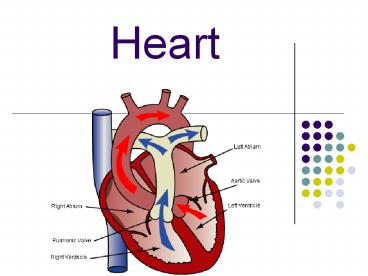Heart - PowerPoint PPT Presentation
1 / 36
Title: Heart
1
Heart
2
Heart
- A large muscle which pumps blood throughout the
body
3
1. Chambers- 4
- Upper right and left atria
- Right-receives de-oxygenated blood from body
- Left- receives oxygenated blood from lungs
4
- Lower Right and Left Ventricle
- Right-pumps blood into lungs
- Left- pumps blood to the body
5
2. Valves- 4
- Diastole Relaxes
- 1. tricuspid valve-regulates blood flow between
Right Atrium (RA) and Right Ventricle (RV) - 2. Mitral Valve- lets Oxygen rich blood from
your lungs pass from LA to LV
6
(No Transcript)
7
- Systole Contraction
- 1. Pulmonary valve - Controls blood flow from rv
into pulmonary arteries go to lungs for O2 - 2. Aortic valve - Opens the way for rich blood
to pass from LV into aorta.
8
3. Double Pump- pumps oxygenated deoxygenated
blood (2)
- Right sideO2 to get more O2.
- Left side receives O2 rich blood and pumps to
whole body.
9
Path of Blood
- Low oxygenated blood enters RA
- Tricuspid valve
- RV
- Contraction (tricuspid-closes, pulmonary-opens)
- Pulmonary artery
10
(No Transcript)
11
- Branches into R L lung
- Gas exchange CO2-O2
- Oxygenated blood enters LA
- Mitral valve
- LV
- Contracts (Mitral-closes, aortic opens)
- aorta
- Fills capillaries
12
Path of Blood- 13 steps
13
(No Transcript)
14
Label the following structures pg. 327
- superior vena cava 10. mitral valve
- inferior vena cava
- RA 11. chordea tendineae
- tricuspid valve 12. LV
- RV 13. aortic valve
- pulmonary valve 14. aorta
- pulmonary arteries 15. papillary mus.
- pulmonary veins 16. septum
- LA 17. apex
15
(No Transcript)
16
(No Transcript)
17
(No Transcript)
18
(No Transcript)
19
- Heart pumping
20
HEART BEAT
- vital sign
- calculated in bpm
- males 70 bpm
- females 75 bpm
- newborn-130 3 years- 100
- 3 months-150 12 years- 85
- 1 year- 125 adult- 60-101
21
A. Heart Rate Abnormalities
- Tachycardia rapid beating of the heart
- Bradycardia slow beating of the heart heart
rate under 60 bpm
22
- Target Heart Rate
- Desired range of heart rate reached during
aerobic exercise.
Age Target HR Zone5085 Average MaximumHeart Rate100
20 years 100170 beats per minute 200 beats per minute
25 years 98166 beats per minute 195 beats per minute
30 years 95162 beats per minute 190 beats per minute
35 years 93157 beats per minute 185 beats per minute
40 years 90153 beats per minute 180 beats per minute
45 years 88149 beats per minute 175 beats per minute
50 years 85145 beats per minute 170 beats per minute
55 years 83140 beats per minute 165 beats per minute
60 years 80136 beats per minute 160 beats per minute
65 years 78132 beats per minute 155 beats per minute
70 years 75128 beats per minute 150 beats per minute
23
Heart Sounds
- LUB-S1 Block reverse blood flow due to closure
of atroventricular valves (mitral, tricuspid) - DUPP-S2 sudden block of reversing blood flow due
to closure of aortic and pulmonary valves.
24
Heart Sounds
- heartbeat
25
Heart Mumors
- Abnormal sounds due to a turbulaet flow of blood
- Causes
- blood flowing faster
- increase in blood
- illnesses (fever, anemia)
26
2. Control of Heartbeat 2 nodes
- SA (sinoatrial) node pacemaker- controls the
frequency at which the heart beats, inside RA and
flows over both atriums.
27
- B. AV (atrioventricular) node picks up impulse
from SA and flows down the septum to carry the
impulse over each of the ventricles.
28
EKG (electrocardiogram)
- the tracing of the hearts electrical activity.
Help diagnose arrhythmias.
29
- 3 types of waves
- P wave records electrical activity of atria
- QRS wave records electrical activity of
ventricles - T wave records the hearts return to rest
30
(No Transcript)
31
Pulse heart rate-rate at which your heart
beats.
Pulse is what you feel over an artery as the
pressure inside increases following each heart
beat.
32
Blood Pressure
- refers to the force exerted by circulating blood
on the walls of blood vessels - Measurement Can be measured invasively (by
penetrating the skin and measuring inside the
blood vessels) or non-invasively
33
- Systolic Pressure maximum pressure in an
artery-beating and pumping - Diastolic Pressure is the lowest pressure in an
artery-resting
34
Why might a solider standing at attention for a
long period of time faint?
- If the leg muscles are not used, blood is not
pumped back to the heart. As a result, blood
pools in the leg veins, and blood pressure falls
35
Main Arteries
36
(No Transcript)































